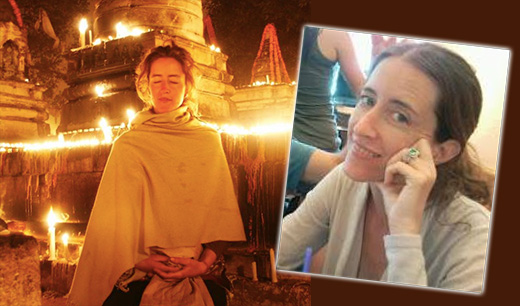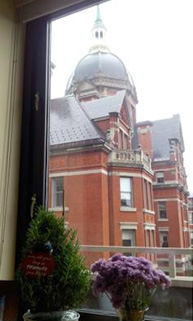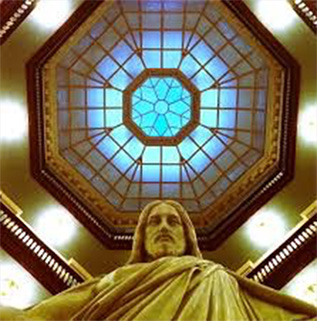Volume 27, 21 December 2014

This winter solstice issue of the newsletter is a departure from my format of the last few years as I wish to lovingly dedicate it to the brilliant light that was on this earth named Sri Purna (Jennifer) Lynch. Together we witnessed and participated in the graceful and inspired dance of the Jyotir Vidya on almost a daily basis. I will miss her as a dear friend, a fellow student of our beloved teacher, a colleague and co-creator and most of all as an inspiration of what is really possible when the full range of the human mind is cultured and awakened.
The articles that follow will be in some way related to Sri - what inspired her, aspects of her personality and her relationship to the Vedic Sampradaya.
“Arise, awake, and stop not until the goal is achieved.”
Adhikari
Adhikari. This beautiful word and Swami Vivekanada’s command sum up why among so many aspirants Sri rose to such a status. All the ingredients were there. She had the will to relentlessly keep her eyes on the target (something our teacher always referred to as “cobra eyes”) and the discipline, willingness and karma to be cultivated by great teachers so that the field made fertile by her labor and devotion would encourage the seeds of knowledge to sprout and grow.
Adhikari can be translated as rightful, qualified or eligible. Those all seem to be simple words but context is everything. When speaking of the deep understanding of the ultimate truth of life as taught, for example, by a guru in the Vedic Sampradaya, it is obvious that not everyone is positioned to receive that knowledge. Some people may have no idea such knowledge exists. Some may know it exists but for whatever reasons reject it out of hand. Others may have an inkling but are busy with other aspects of their life and do not explore it. It takes a very special confluence to give rise to a person whose soul-strings resonate with a teacher and the teachings to the extent that the student is a perfect receptacle and in turn becomes that teaching and propagates it. In fact, it is the duty of the guru to find such students to keep the tradition viable.
There are all levels of adhikari. Sri demonstrated again and again to her teachers that she had the cobra eyes, the intelligence, the incredible work ethic and the relentless desire to aspire to that central bindu (singular point) - the knowledge by which everything else is known.
The Majesty of Vastu
Sri spent most of her last weeks at the original campus of Johns Hopkins Hospital in downtown Baltimore. The room she was in looked out at the iconic dome which is the “branding” of Johns Hopkins even on the placemats and doormats of the facility
On one of the last days in which she mustered the strength to go on “an outing”, she requested that we take her to that original building. We speculated on whether there would be a library under that dome or a lecture hall. We were all wrong. When we wheeled her into the ground floor we saw that the entire space under the dome five stories up was a Brahmasthana - an open, airy sacred space in the middle of the structure.
There was, however, one object in the center of that Brahmasthana which normally should not be occupied but in this case, it was a sacred sculpture in the form of a giant and compelling statue of Christ. Sri immediately noted that the sculptor had encoded several markings indicating the great spiritual status of Christ. These markings would not have been known to the casual observer. We were blown away that despite the heavy medications, she was as sharp and subtle as ever. The base of the sculpture was strewn with letters of hope and prayer, flowers and other offerings adding even more to the grace and protection we all felt in this edifice.
She insisted that we take her up the elevator and we stopped at every floor so she could circumambulate the Brahmasthana and absorb the impact of the majestic eight-petalled dome above. When we got to the top floor, she could see it even more clearly. She looked straight at us and said, “This is why Johns Hopkins is the great institution it is today and why it has prospered and endured. I am going to write an article on the vastu of this building and show how all the highest principles were incorporated into this structure.”
She began to tire and we took her back to her room. When any staff came into the room, she engaged them with her revelations about the vastu and requested history books so she could begin her research on the siting and construction of that initial building and also the life of Johns Hopkins as the merit of enabling such a building must be in some way reflected by the owner.
Sri obviously did not live to complete this project but she did light a fire in me to more vigorously pursue Vastu - the vidya she had to come to realize had the capacity to make huge differences more tangibly and quickly in everyone’s lives. I hope someday to write that article on that noble building at Johns Hopkins in her honor.


And What is it all About?
In the many hours I had to think about what I was witnessing in Sri’s decline and passing and how to frame this experience which will inform the rest of my life, I recalled a conversation with my teacher Hart. We were discussing the passion I have for Jyotisha and for teaching. He was very gentle but very clear in what he communicated. I will paraphrase it as best I can. While we exist as incarnated beings, we must all do our karmas (actions). It is very fortunate to find something that is sattvic and knowledge is sattvic. But even sattvic activity is, in the end, a trap.
I can’t take Jyotisha with me anymore than Sri could take her Vastu project with her.
And so, once again, I was very inspired to see how Sri spent most of the time left to her. She turned to the Upanishads and the Gita so that she could open to the ultimate purushartha of Moksha. Everyday until the end she, and/or those around her, chanted and did practices that smoothed that journey to the divine and ultimately she left us shining like a Devi with sacred verses and offerings ensuring her safe passage into perfect peace and wholeness.
The Media Corner - Graceful Exits: How Great Beings Die
This book is especially poignant as the author, Sushila Blackman, was exploring 108 conscious and graceful stories in preparation for her own transition which took place within a couple of months of the completion of this work. The focus is on Masters of the Eastern traditions - Tibetan, Hindu and Zen and the ability to face this most primal of all experiences with calm and peace. Some members of the team that surrounded Sri in her final weeks were very comforted after reading this book.
